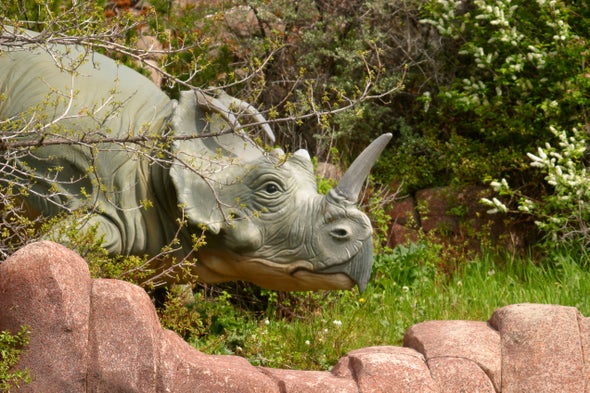(单词翻译:单击)
听力文本
This is Scientific American's 60-second Science, I'm Emily Schwing.
"Given that hundreds of thousands of dinosaur bones have been dug up, is there any evidence that dinosaurs got cancer?"
David Evans, senior curator of paleontology at the Royal Museum of Ontario in Toronto.
"There had been a few studies that had kind of suggested, based on gross anatomy, that dinosaurs might have gotten cancer. But there was nothing compelling from a medical standpoint. And from that point on, we decided to go on a hunt for rare dinosaur diseases, in particular cancer."
So in 2017, Evans and colleagues went digging through a collection of dinosaur bones at the Royal Tyrrell Museum of Paleontology in Alberta—a hotbed of dinosaur fossils.
"And out of the hundreds of dinosaur bones that we looked at, we found one that was a candidate for bone cancer."
The bone specimen Evans and his colleagues found comes from a dinosaur that roamed western Canada between 70 and 75 million years ago. The creature is called a Centrosaurus.
"Centrosaurus is a horned dinosaur. It's about the size of a rhinoceros, and it's a close cousin of the famous triceratops, so it looked very similar. It would have a parrot beak at the end of its large skull. It had a neck shield similar to triceratops and walked around on four feet and ate plants."
Its apparent cancer is a particularly aggressive type.

"And this would have made it more vulnerable to the top predators at the time, which were the cousins of T. rex. But we actually don't think it's the cancer that killed this animal—even though, if it would have been allowed to run its course, it certainly could have been fatal."
The tumorous bone was discovered among thousands of other bones from the same species. All these animals appeared to have died in a coastal flood.
"And this flood looked like it killed a herd of these horned dinosaurs, Centrosaurus, which are known for living in these social groups. And we suspect, although we can't prove, that the cancer could get to such an advanced state because this animal was able to benefit from the safety of numbers of being in a herd. Whereas if it was out on its own, with this devastating disease, it would certainly have had a good chance of being picked off before the cancer progressed this far."
The study is in the journal Lancet Oncology.
Evans says the research introduces a new way to study paleopathology in the fossil record.
"You know, this discovery definitely takes dinosaurs, which we often think of as almost mythical, powerful creatures, and, I think, it shows that they were real animals in a way that's really unique and sobering that they got diseases similar to the ones that humans get today. And they would have suffered greatly from these diseases, and so it brings them to life in a really unusual way."
Thanks for listening for Scientific American's 60-second Science. I'm Emily Schwing.
参考译文
这里是科学美国人——60秒科学系列,我是埃米莉·施温。
“鉴于已挖掘出数十万块恐龙骨骼,那有没有证据表明恐龙得了癌症?”
多伦多安大略皇家博物馆的古生物高级馆长大卫·埃文斯说到。
“有一些研究表明,基于大体解剖学,恐龙可能得了癌症。但从医学角度来看,没有什么令人信服的证据。从那时起,我们决定继续寻找罕见的恐龙疾病,特别是癌症。”
因此,2017年,埃文斯和同事在阿尔伯塔省皇家泰瑞尔古生物博物馆——恐龙化石的温床——挖掘了一批恐龙骨骼。
“在我们观察的数百块恐龙骨骼中,我们发现了一个骨癌候选人。”
埃文斯和同事发现的这个骨骼标本来自7000万至7500万年前在加拿大西部漫步的恐龙。这种生物被称为“尖角龙”。
“尖角龙是一种角龙。其体型与犀牛差不多,是著名的三角龙的近亲,所以看起来非常相似。它的大头骨末端有一个鹦鹉喙。它有类似三角龙的颈盾,用四只脚行走,以植物为食。”
其明显的癌症是一种极具侵略性的类型。
“这将使它更容易受到当时顶级捕食者的攻击,这些捕食者是霸王龙的表亲。但我们实际上并不认为是癌症杀死了这只动物,尽管如果任癌症发展下去,肯定会令其致命。”
这根肿瘤骨是在同一物种的数千块其他骨骼中发现的。所有这些动物似乎都死于沿海洪水。
“这场洪水似乎杀死了一群尖角龙,它们以大量群居而闻名。尽管无法证明,但我们怀疑癌症可能会发展到如此晚期的阶段,是因为这种动物能够从群体数量的安全中获益。然而,如果患有这种毁灭性疾病的个体独自外出,那它肯定有很大几率在癌症发展到如此严重之前就被杀死。”
这项研究发表在《柳叶刀·肿瘤学》期刊上。
埃文斯表示,这项研究引入了一种新的方法来研究化石记录中的古病理学。
“这一发现无疑将恐龙——我们通常认为是神话般强大的生物,但我认为这表明它们是真正的动物——带入相当独特且令人深省的形象,它们患上了与如今的人类相似的疾病。它们会因为这些疾病而遭受巨大的痛苦,而这以非常独特的方式让恐龙的形象生动有趣起来。”
谢谢大家收听科学美国人——60秒科学。我是埃米莉·施温。
译文为可可英语翻译,未经授权请勿转载!
重点讲解
重点讲解:
1. in particular 尤其;特别;
The situation in Ethiopia in particular is worrying.
埃塞俄比亚的局势尤其令人担忧。
2. run its course 任其发展;听其自然;
They estimated that between 17,000 and 20,000 cows would die before the epidemic had run its course.
他们估计在流行病结束之前会有17,000到20,000头牛死去。
3. pick off 逐个瞄准射中;
Both groups on either side are just picking off innocent bystanders.
对峙双方都只是在瞄准射击无辜的旁观者。
4. bring sth. to life (使)变得生动;(使)变得有趣;
The cold, hard cruelty of two young men is vividly brought to life in this true story.
这个真实的故事把两个年轻人的冷酷残忍刻画得入木三分。
关注微信公众号【可可双语精读】,获取详细讲解内容


